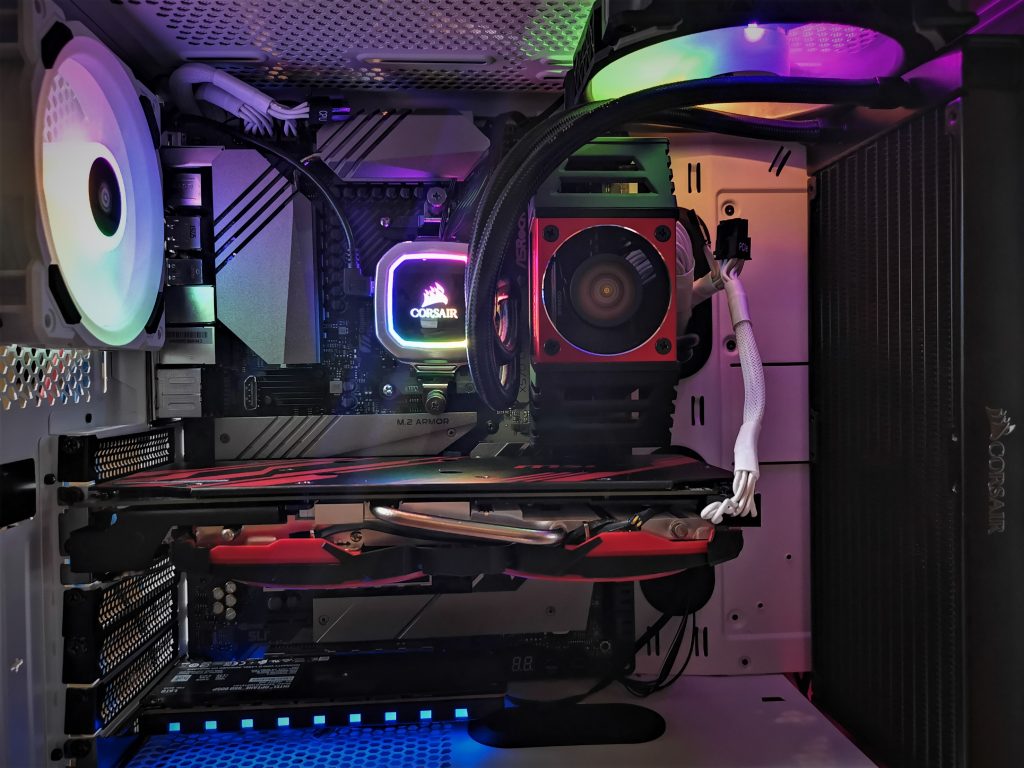TSSDR TEST BENCH AND PROTOCOL
SSD testing at TSSDR differs slightly, depending on whether we are looking at consumer or enterprise storage media. For our Corsair MP600 Gen 4 NVMe M.2 SSD testing today, our goal is to test in a system that has been optimized and will reach top speeds possible.
We are using a brand new ASRock X570 Creator Test bench which is AMD based and contains the AMD Ryzen 3700x Gen 4 CPU. Our PC has been overclocked from 3600Mhz to 4300MHz and memory has been set at a XMP profile of 3600MHz where the system performs best.
The components of this Test Bench are detailed below. All hardware is linked for purchase and product sales may be reached by a simple click on the individual item. As well, the title is linked back to the individual build article where performance testing can be validated.
TSSDR ASROCK CREATOR GEN 4 X570 TEST BENCH (link)
| PC CHASSIS: | Corsair iCue 465x Mid-Tower White ATX RGB |
| MOTHERBOARD: | ASRock X570 Creator PCIe 4.0 |
| CPU: | AMD Ryzen 3700x |
| CPU COOLER: | Corsair Hydro H115i Platinum Liquid Cooling |
| POWER SUPPLY: | Corsair White RM750x 80Plus |
| GRAPHICS: | MSI Armor Mk 2 Radeon RX570 OC |
| MEMORY: | Corsair Vengeance LPX DDR4 3600MHz |
| STORAGE: | Intel Optane 905P 1.5TB SSD |
| KEYBOARD: | Corsair K57 Wirless Gaming |
| MOUSE: | Corsair Dark Core RGB SE Wireless BT Gaming |
| OS | Microsoft Windows 10 Pro 64 Bit |
BENCHMARK SOFTWARE
The software in use for today’s analysis is typical of many of our reviews and consists of Crystal Disk Info, ATTO Disk Benchmark, Crystal Disk Mark, AS SSD, Anvil’s Storage Utilities, AJA, TxBench, and we will be conducting true testing data transfer comparisons. Our selection of software allows each to build on the last and to provide validation to results already obtained.
Crystal Disk Info is a great tool for displaying the characteristics and health of storage devices. It displays everything from temperatures, the number of hours the device has been powered, and even to the extent of informing you of the firmware of the device.
Crystal Disk Info validates that our SSD is running in PCIe 4.0 x4 (four lane), and also that NVMe 1.3 protocol is in use.
 The SSD Review The Worlds Dedicated SSD Education and Review Resource |
The SSD Review The Worlds Dedicated SSD Education and Review Resource | 


Was the testing done in the CPU native NVMe port or the PCH connected NVMe port?
Kudos… I slipped. Thank you. Will be reposting benchmarks before night end. All but one displayed improvement.
Really what a nice product combination of all aspects required for a small technical component are featured in it in a well defined manner hats off for it.
Review of these devices help to mention their capacity and power to use all the various set of features are discussed and covered under it.
I t will be nice when there are more MPCIe 4.0 (Gen 4) NVMe SSD controllers other than the Phison with its PSE5016-E16. I have a feeling there is much more potential with the Gen 4 SSDs that we will see, hopefully in the very dear future, as everyone should already have their controllers out and being used, as they’ve had more than enough time for product development.
In any case, I’m anxiously awaiting many more reviews of Gen 4 SSDs.
Thanks, Les
I want to use this drive as a Windows boot drive but ALSO run a couple virtual machines on the same drive. Will WIndows performance suffer while the VMs are running?
Can I use this drive in a PCIe Gen3 mobo?
As a PCIe 4.0 SSD, the MP600 delivers incredible storage performance, and is fully backwards compatible with current PCIe 3.0 platforms. It is equipped with a high surface area aluminum heatsink, helping to maintain its performance even under heavy load.